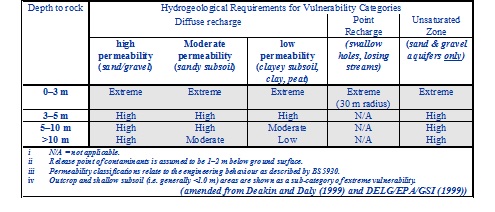The link between 'groundwater vulnerability' and the 'pathway'
 Groundwater vulnerability is based on evaluating the relevant hydrogeological characteristics of the geological materials along the pathway. Therefore it is assessed on the basis of the (largely) vertical transport of recharge water and contaminants from the point of release of contaminants to the uppermost groundwater target encountered, whether in a bedrock or sand & gravel aquifer (see Figure 3). This will be the water table, where the water table is in the bedrock or sand/gravel, or alternatively it will be the top of the bedrock or sand/gravel where the water table or potentiometric surface is in the overlying subsoil. It will not be the groundwater encountered in overlying subsoils, as this groundwater is not given a value as it is not used directly for water supply. Therefore, conditions along the pathway may be saturated or unsaturated or both.
Groundwater vulnerability is based on evaluating the relevant hydrogeological characteristics of the geological materials along the pathway. Therefore it is assessed on the basis of the (largely) vertical transport of recharge water and contaminants from the point of release of contaminants to the uppermost groundwater target encountered, whether in a bedrock or sand & gravel aquifer (see Figure 3). This will be the water table, where the water table is in the bedrock or sand/gravel, or alternatively it will be the top of the bedrock or sand/gravel where the water table or potentiometric surface is in the overlying subsoil. It will not be the groundwater encountered in overlying subsoils, as this groundwater is not given a value as it is not used directly for water supply. Therefore, conditions along the pathway may be saturated or unsaturated or both.
Vulnerability and contaminant type
When assessing vulnerability of groundwater below a particular area or site, the characteristics of individual contaminants are not taken into account. The vulnerability would be the same for a readily degradable compounds like certain pathogens or petroleum products as it would be for highly resistant compounds like nitrates and chlorinated solvents.
In other words, a vulnerability assessment will assume that the contaminants are conservative (i.e. they do not attenuate or break down readily, and they move at a similar rate to water itself). The contaminant type and loading rate, along with vulnerability, targets, etc, are collated independently and the risk posed by a particular activity is then assessed by considering the elements together.
